Trans-America USA + Mexico Overland 9,000-mile 31-day Roadtrip | Part 15 | Slot Canyons & Sacred Lands | Glen Canyon, Lake Powell, Antelope Canyon, Tuba City & Ghosts of Route 66 on Hwy 89 to Flagstaff
 |
| Beams of Sunlight entering Antelope Canyon X |
Good evening, fellow wanderers! It’s us, the Vagabond Couple, back with another chapter of our 9,000-mile odyssey across North America (USA & MExico). In the last episode, we checked into Page, Arizona after a memorable drive from Grand Canyon to Page, AZ - Chasing Sunrises, Towering Echo Cliffs, Painted Desert Dreams & an Iconic River Bend (the Horseshoe Bend). After a restful night in Page, Arizona, we woke up to a day that promised two of the Southwest’s most iconic wonders: the engineered majesty of Lake Powell and the natural artistry of Antelope Canyon's Canyon X. What followed was a journey through water and stone, history and legend and some of the most surreal landscapes we’ve ever witnessed.
Glen Canyon & Lake Powell: Where Engineering Meets Eden
 |
| Glen Canyon: Downstream side of Glen Canyon Dam on Colorado River |
We began our day at Glen Canyon Dam, a 710-foot-tall concrete arch dam that tames the mighty Colorado River. Built in the 1960s, this engineering marvel created Lake Powell, the second-largest reservoir in North America (after Lake Mead created by Hoover Dam also on the Colorado in Arizona).
 |
| Glen Canyon Dam on Colorado River |
Standing on the dam’s overlook, we marveled at how humans had sculpted the land - but the real magic lay beyond. Lake Powell is named after Major John Wesley Powell, a one-armed American Civil War veteran, geologist and explorer who led the first documented expedition down the Colorado River through the Grand Canyon in 1869. His daring journey mapped much of the region, including the area that would later be flooded by the creation of the Glen Canyon Dam in 1963, forming Lake Powell. The reservoir was named in his honor to recognize his contributions to the exploration and scientific study of the Colorado River and the surrounding canyonlands.
 |
| Lake Powell |
Lake Powell is a liquid desert dream. Its nearly 2,000 miles of shoreline twist through red rock canyons, creating a maze of sapphire water and towering sandstone. Rainbow Bridge is one of the world’s largest natural bridges (sacred to the Navajo, who call it "Nonnezoshe", or "rainbow turned to stone"). As the sun set, the marina glowed with golden light, reflecting off the water like a Monet painting.
 |
| Lake Powell |
Lake Powell is the massive man-made reservoir formed by the Glen Canyon Dam on the Colorado River. Spanning over 186 miles in length with nearly 2,000 miles of shoreline, it is the second-largest reservoir in the U.S. by capacity, holding approximately 24 million acre-feet of water when full.
The lake, part of the Glen Canyon National Recreation Area, is renowned for its striking red-rock canyons, clear blue waters and recreational opportunities, including boating, fishing and hiking.
 |
| Lake Powell |
But there’s irony here: the lake’s beauty came at a cost. The dam flooded Glen Canyon, a place John Muir might have called "the Grand Canyon’s mysterious cousin." Ancient Ancestral Puebloan ruins now lie submerged and the antelope that once roamed nearby vanished when their migration paths were cut off, leaving behind an Antelope Canyon with no antelopes.
 |
| Lake Powell |
Additionally, prolonged drought and climate change have significantly impacted water levels, with the lake often operating at less than 50% capacity in recent years. Despite these challenges, Lake Powell remains a vital water source for the Southwest and a major tourist destination, attracting millions of visitors annually.
 |
| Lake Powell |
As the sun dips below the crimson cliffs of Glen Canyon National Recreation Area, the sky ignites in hues of gold, pink and purple, casting a warm glow over the tranquil waters of Lake Powell. Boats gently sway at the dock, their silhouettes mirrored on the shimmering surface as the day’s last light fades.
 |
| Lake Powell Marina, Glen Canyon National Recreation Area |
The surrounding sandstone walls, carved by centuries of wind and water, deepen into rich oranges and reds, creating a breathtaking contrast against the darkening sky. The air cools, carrying the faint sounds of laughter from departing visitors and the soft lapping of waves against the shore. In this serene moment between day and night, the landscape transforms into a peaceful haven, perfect for reflection and quiet admiration of nature’s beauty.
 |
| Lake Powell Marina, Glen Canyon National Recreation Area |
Antelope Canyon: Light Beams & Holy Silence
 |
| Entering Navajo Nation |
The next morning, we entered Navajo Nation for a pilgrimage to Antelope Canyon X, a lesser-known and less crowded, but equally stunning, sibling to more touristy Upper and Lower Antelope Canyon.
 |
| Antelope Canyon X entrance, Navajo Nation |
Antelope Canyon, the mesmerizing slot canyon in Arizona, captivates visitors with its undulating sandstone walls, sculpted by centuries of wind and water into flowing, wave-like formations.
 |
| Path descending into Antelope Canyon X |
Descending into Antelope Canyon X is like stepping into a hidden world, where a series of steps adjacent to a trail guide visitors down the rugged sandstone walls into the depths of the slot canyon.
 |
| Sandstone walls at Antelope Canyon X |
The stairs dusted with fine red sand and the path next to it (you can walk the path or climb the stairs as you wish) lead deeper into the canyon’s sinuous curve.
 |
| Sandstone walls of Antelope Canyon X |
This downward walk makes for a breathtaking descent into one of nature’s most exquisite masterpieces.
 |
| Antelope Canyon X, Navajo Nation |
What makes it truly magical is the interplay of light and shadow - especially at midday, when sunlight pierces through narrow openings above, creating luminous beams that cascade through the dusty air before softly illuminating the canyon floor.
 |
| Sunlight beam at Antelope Canyon X |
The warm hues of orange, pink and gold shift with the sun’s movement, casting an ethereal glow on the smooth, curved walls.
 |
| Antelope Canyon X, Navajo Nation, Arizona |
Dust particles suspended in the air catch the light, making the sunbeams appear almost solid, like golden pillars descending from the sky.
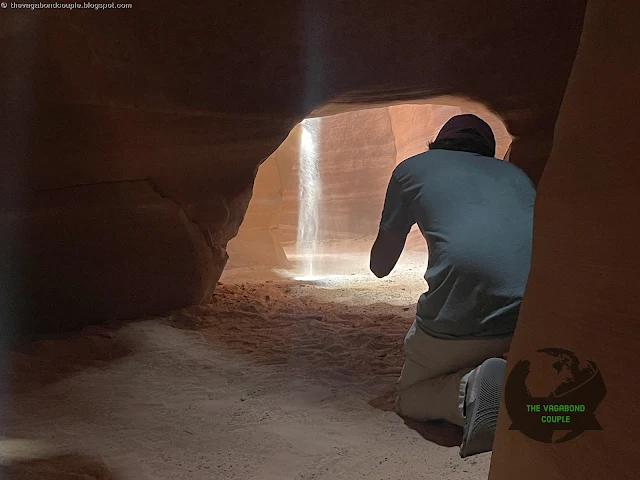 |
| Sunlight beam at Antelope Canyon X |
This breathtaking dance of light and stone transforms the canyon into a natural cathedral, leaving visitors in awe of its delicate, otherworldly beauty.
 |
| Antelope Canyon X, Navajo Nation |
Here’s why this place is magic. However, also keep in mind the great negative ecological impact of building Glen Canyon Dam and flooding of Glen Canyon creating Lake Powell. Antelope Canyon’s namesake animals vanished after Lake Powell’s creation. The Navajo say their spirits still dance in the canyon’s light beams at noon.
The Canyons
 |
| Antelope Canyon X |
Canyon X is actually two slot canyons - Mother Canyon and Father Canyon - each with its own personality. Mother Canyon is wider, with soft, flowing walls that look like draped silk.
 |
| Antelope Canyon X |
Father Canyon is narrower, with sharp angles and beams of light that pierce the darkness like celestial spotlights.
 |
| Antelope Canyon X |
The Geology
 |
| Antelope Canyon X |
These canyons were carved by flash floods over millions of years. When it rains, water still rushes through the depths (our Navajo guide showed us marks from recent floods 20 feet up the walls!).
 |
| Antelope Canyon X |
The sandstone’s swirls are a ledger of time, with iron oxide painting streaks of red and purple.
The Culture
 |
| Antelope Canyon X |
The Navajo (or Diné) have stewarded this land for centuries. Our tour was led by a Navajo family, who shared stories of the canyon’s spirits - "Yei" - who dwell in the rocks. Photography is sacred here; every shot requires permission from the wind.
Lizards
There are plenty of lizards in the area going about their business. We caught a couple posing for us on camera. At Antelope Canyon, the most commonly seen lizards are species adapted to the desert environment.
 |
| A Rare Collared Lizard at Antelope Canyon |
- Desert Spiny Lizard (Sceloporus magister) – A sturdy, sun-loving lizard with spiky scales, often seen basking on rocks.
- Side-blotched Lizard (Uta stansburiana) – A small, fast-moving lizard with distinctive markings behind its forelimbs.
- Western Fence Lizard (Sceloporus occidentalis) – Recognizable by its blue belly (in males) and preference for rocky perches.
- Collared Lizard (Crotaphytus nebrius) – Less common but striking, with bright colors and a bold, leopard-like pattern.
 |
| Baby Desert Lizard at Antelope Canyon |
These reptiles thrive in the canyon’s sandy, rocky terrain and are most active during warmer months. While touring Antelope Canyon, we spotted them darting across the sandstone or clinging to shaded crevices to escape the heat.
A Video Tour of Antelope Canyon X
In summary, Antelope Canyon X presents a breathtaking spectacle of nature's artistry, where smooth, undulating sandstone walls curve and twist, painted in hues of vibrant oranges, reds, and purples that shift with the changing light. The deep, narrow passages create an intimate and awe-inspiring experience, with sunlight filtering down to illuminate the canyon's depths, revealing the intricate textures and wave-like formations carved by millennia of wind and water erosion, offering a more secluded and personal experience than the more visited portions of Antelope Canyon.
Watch: Astonishing Beauty! Antelope Canyon X - Navajo Nation Tour (Arizona) | Antelope Canyon | Page, AZ
Environmental Damage: Antelope Canyon with no more Antelopes
The flooding of Glen Canyon and creation of Lake Powell in 1963 dramatically altered the region’s ecology and disrupted traditional Navajo hunting grounds. The rising waters submerged ancestral grazing lands and migration routes for pronghorn antelope, fragmenting their habitat and reducing their populations. Navajo hunters, who once relied on the canyon’s resources for sustenance, lost critical foraging areas and sacred sites beneath the reservoir’s expanse.
The local ecology also shifted as native cottonwood and willow stands drowned, while invasive species like tamarisk took hold along the new shoreline. The river’s natural sediment flow was blocked, affecting downstream ecosystems and the once-dynamic canyon ecosystem became a stagnant lake, altering plant and animal life forever.
Though Lake Powell brought economic opportunities, its environmental and cultural costs remain deeply felt by the Navajo people and the land’s original inhabitants.
Ghosts of Route 66: Page to Flagstaff on Highway US-89
The next morning, we drove south on US-89, a road that we keep meeting across Arizona, Utah, Idaho, Wyoming and Montana and that sings with Americana. Here are a couple of our memorable stops.
Painted Desert Project
 |
| The Painted Desert Project |
Rolling down Highway 89 near Cameron, AZ, we stumbled upon something unexpected - massive, vibrant murals splashed across old buildings and roadside structures. This is the Painted Desert Project, a powerful mix of street art and Native history that turns abandoned spaces into living storytelling canvases.
 |
| The Painted Desert Project |
Spearheaded by artist Jetsonorama (aka Dr. Chip Thomas, a longtime doctor on the Navajo Nation), the project brings together artists from around the world to create murals reflecting Navajo culture, struggles and beauty.
 |
| The Painted Desert Project |
These stunning works sit against the backdrop of the endless Arizona desert, honoring the stories of the Diné people - stories of resilience, sacred landscapes and deep spiritual connections to the land.
 |
| The Painted Desert Project |
But this land has been speaking for centuries, long before paint ever touched these walls.
 |
| The Painted Desert Project |
The Navajo, or Diné, have lived here for hundreds of years, believing in the sacred harmony of nature and spirit.
 |
| The Painted Desert Project |
The towering mesas and wide-open plains hold legends of Changing Woman, Monster Slayer and the Holy People, who shaped the world. Even today, these stories echo through the red rocks and shifting sands.
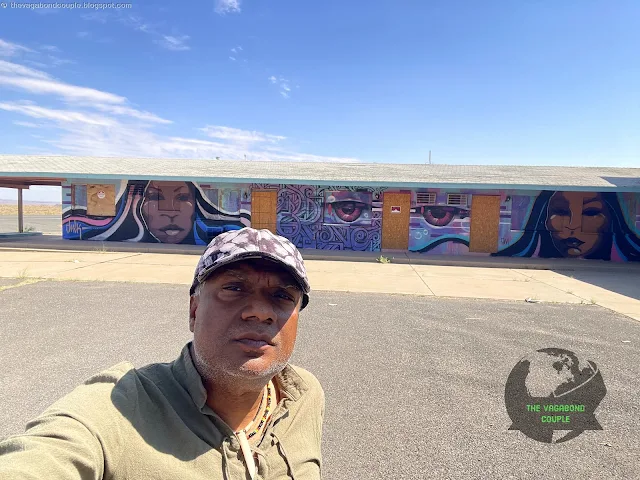 |
| The Painted Desert Project |
Dr. Chip Thomas (aka Jetsonorama) is more than just a street artist - he's a physician who has lived and worked on the Navajo Nation for over three decades. Inspired by the people he serves, he started the Painted Desert Project, inviting artists from around the world to create large-scale murals that celebrate Navajo history, culture and social issues.
 |
| The Painted Desert Project |
The project has featured renowned street artists like Jet Martinez, ROA, Mata Ruda and Doodles, blending their unique styles with Diné stories and imagery.
 |
| The Painted Desert Project |
One of the most striking installations is an abandoned gas station, its weathered walls covered in haunting graffiti and portraits, with an eerie speaker inside playing the soft sound of dripping water - a powerful nod to the scarcity of water on the Navajo Nation and the ongoing struggle for clean access.
 |
| The Painted Desert Project |
This fusion of art and activism turns forgotten spaces into thought-provoking experiences, making the Painted Desert Project a true roadside masterpiece.
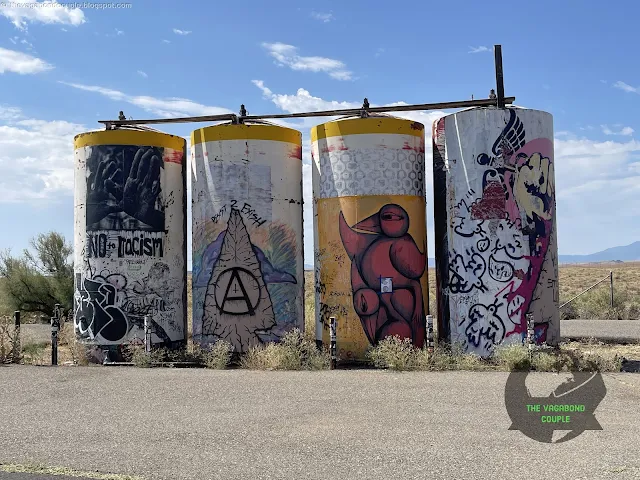 |
| The Painted Desert Project |
The Painted Desert Project gives a modern voice to this ancient land, blending past and present into something truly unforgettable.
 |
| The Painted Desert Project |
So, if you ever find yourself on Hwy 89 near Cameron, slow down and take it in - because here, art isn’t just decoration; it’s history, resistance and a love letter to the Navajo homeland.
 |
| The Painted Desert Project |
Sunset Crater Volcano
Closed due to wildfires, but we glimpsed its charcoal slopes - a reminder that this land is still alive with geologic fire.
 |
| Sunset Crater Volcano |
Sunset Crater Volcano, a cinder cone in northern Arizona, was formed by a powerful eruption just a 1,000 years ago, dramatically reshaping the landscape with lava flows and ash deposits. This eruption, one of the most recent in the San Francisco Volcanic Field, forced ancient Sinagua people to relocate but also enriched the soil, supporting agriculture in nearby areas.
 |
| Sunset Crater National Monument |
However, access to Sunset Crater National Monument has been recently affected by wildfires, with the 2022 Tunnel Fire severely damaging parts of the park and forcing road closures. While recovery efforts continue, the site remains a striking reminder of both the Earth's raw power and the delicate balance between fire and renewal in the American Southwest.
Tuba City: War Heroes, Fried Bread & Roast Mutton
 |
| Tuba City, Navajo Nation |
We reached Flagstaff and turned around to head north back on Hwy 89. After crossing Cameron, we took a detour on eastbound Hwy US-160 to re-enter Navajo Nation, heading to Tuba City, a place where history hums in the red dust.
The drive from Highway 89 to Tuba City via U.S. Highway 160 is another journey through the heart of the Navajo Nation, where vast desert landscapes stretch endlessly under the Arizona sky. As we turn onto US-160, the scenery shifts - painted mesas, rugged rock formations and the ever-present silhouettes of buttes rising in the distance.
The land here tells ancient stories, with layers of red and ochre earth shaped by millennia of wind and water. Along the way, we pass Coal Mine Canyon Road, an unmarked gem hiding one of the most breathtaking and least-visited canyons in the Southwest.
The road itself is well-paved and easy to drive, but the true beauty lies in the surrounding landscape - open plains dotted with occasional traditional Navajo hogans, wild horses roaming free and roadside stands selling authentic fry bread and handmade jewelry. As we approach Tuba City, we see the signs for the Dinosaur Tracks, a must-stop spot where locals guide visitors to 200-million-year-old fossilized footprints.
 |
| Tuba City, Navajo Nation |
The town of Tuba City itself, named after a Hopi chief, is the largest community in the Navajo Nation and a gateway to deep Indigenous history, culture and some of the best home-cooked roast mutton we will ever taste.
WWII Navajo Code Talkers
This portion of U.S. Highway 160 is designated as the Native Americans Veterans Memorial Highway in honor of the Indigenous men and women who have served in the U.S. Armed Forces. This designation recognizes the long-standing tradition of military service among Native American communities, including the Navajo, Hopi, Ute and other tribes who call the Southwest home.
 |
| Sign honoring WW-II Navajo Code Talkers at entrance to Tuba City |
As we drive through Navajo Nation on US-160, we are traveling through land rich in history and culture. Many Native American veterans, including the legendary Navajo Code Talkers of World War II, hailed from this region. Road signs marking this memorial highway serve as a reminder of their sacrifices and contributions. The code word for America was "Our Mother" in Navajo, "Ne-he-mah".
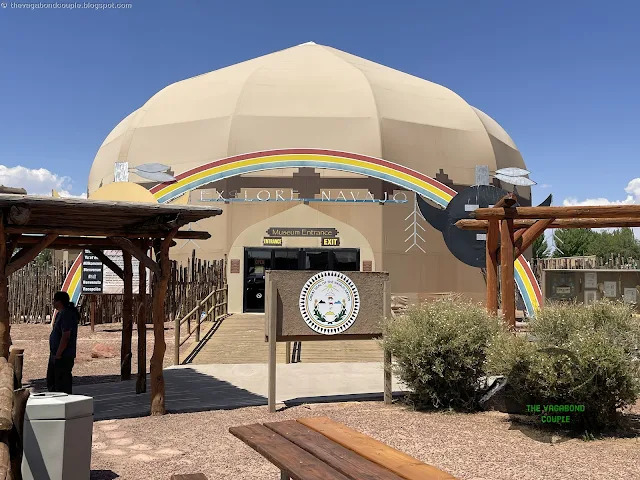 |
| Tuba City Navajo Museum: Explore Navajo |
Along this stretch, we also find roadside monuments, veteran memorials and murals dedicated to Native warriors, blending history, patriotism and Indigenous heritage into the landscape of the American Southwest.
 |
| Tuba Trading Post |
At a small museum in Tuba City, we met a descendant of the Code Talkers who used the Navajo language to create unbreakable military codes. "The Germans never cracked it" he said proudly. "Our words were weapons."
 |
| Tuba Trading Post |
Hidden Fry Bread & Roast Mutton Stands
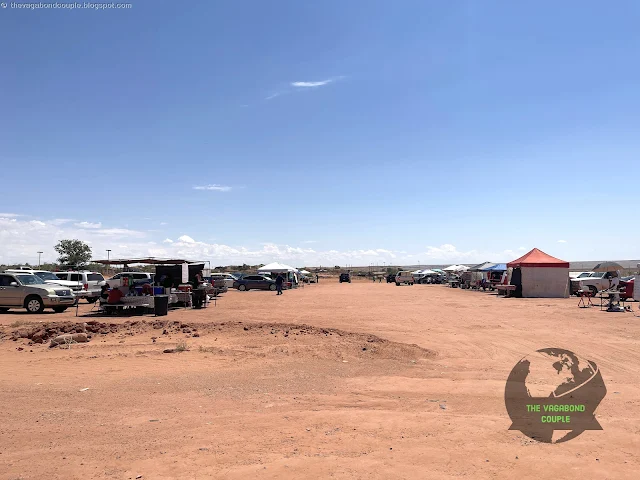 |
| Open air market at Tuba City |
Hidden at the back of the town behind the bustling Main Street area, we found an open-air market where Navajo grandmothers cooked fry bread and roast mutton over open flames. We sat with locals, tearing into fluffy, golden bread piled with roast mutton and honey. "This is the real Arizona", laughed a Navajo lady who is a weaver. Her stories of Changing Woman and Coyote made the meal a feast for the soul.
 |
| Fry Bread and Roast Mutton stall at open air market in Tuba City |
Navajo Fry Bread and Roast Mutton are two iconic staples of Navajo cuisine, each carrying deep cultural and historical significance. Fry bread, a golden, pillowy flatbread, was created out of necessity when the U.S. government forced the Navajo people onto the Long Walk in 1864, providing them only with rations like flour, salt and lard. Over time, this simple survival food became a cherished dish, often served with honey, powdered sugar, or as the base for savory Navajo tacos piled high with beans, cheese and ground beef.
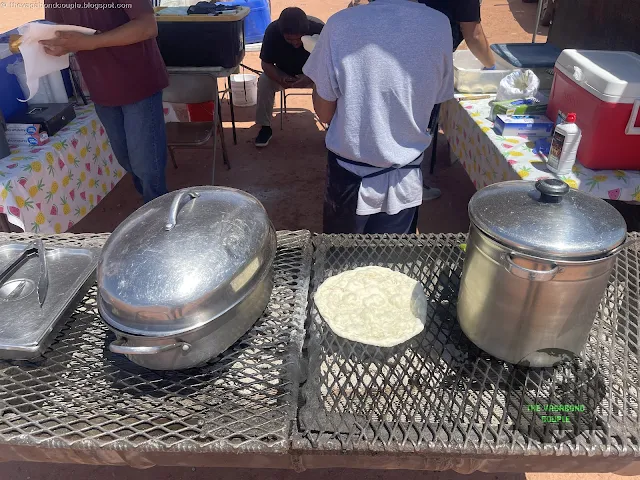 |
| Fry bread being fried at roadside open market stall in Tuba City |
Roast mutton, on the other hand, reflects the traditional Navajo shepherding lifestyle, introduced after the Spanish brought sheep to the Southwest in the 1600s. Slow-roasted over an open flame or grilled, the rich, smoky flavor of the mutton pairs perfectly with fry bread or fresh tortillas.
 |
| Fresh, hot & delicious Navajo Fry Bread & Roast Mutton meal at Tuba City |
Whether enjoyed at a roadside stand in the Navajo Nation like we did, or at a family gathering, these dishes are more than just food - they are a connection to heritage, resilience and the enduring spirit of the Navajo people.
 |
| Fry Bread and Roast Mutton stall at roadside open air market in Tuba City |
Odometer Check & Tomorrow’s Adventure
 |
| Shehzadi odometer 11,939 miles = 5,544 miles from home |
Back in Page, Shehzadi’s odometer hit 11,939 miles - an astonishing 5,544 miles since we left Maryland!
Tomorrow, we’ll chase the iconic landscapes around the area of the San Juan mountains and San Juan River - Monument Valley, Mexican Hat, Valley of the Gods, and the stunning beauty of the San Juan river at its double bend at Gooseneck State Park (see A Sacred Landscape, Monuments to Gods & Ancient Whispers: Monument Valley, Valley of the Gods, Mexican Hat, Gooseneck State Park, Bluff, Utah to Durango, Colorado). But for now, we’re savoring the echoes of slot canyons and the taste of fry bread.
Until next time, keep wandering - but always with respect for the land and its people.
P.S. Shehzadi’s check engine light finally came on today… just kidding! This truck is indestructible!
Reference route map of The Vagabond Couple's 9,000-mile USA & Mexico overland roundtrip: Map-1 and Map-2.
- The Vagabond Couple and Shehzadi 🚙💨


0 comments